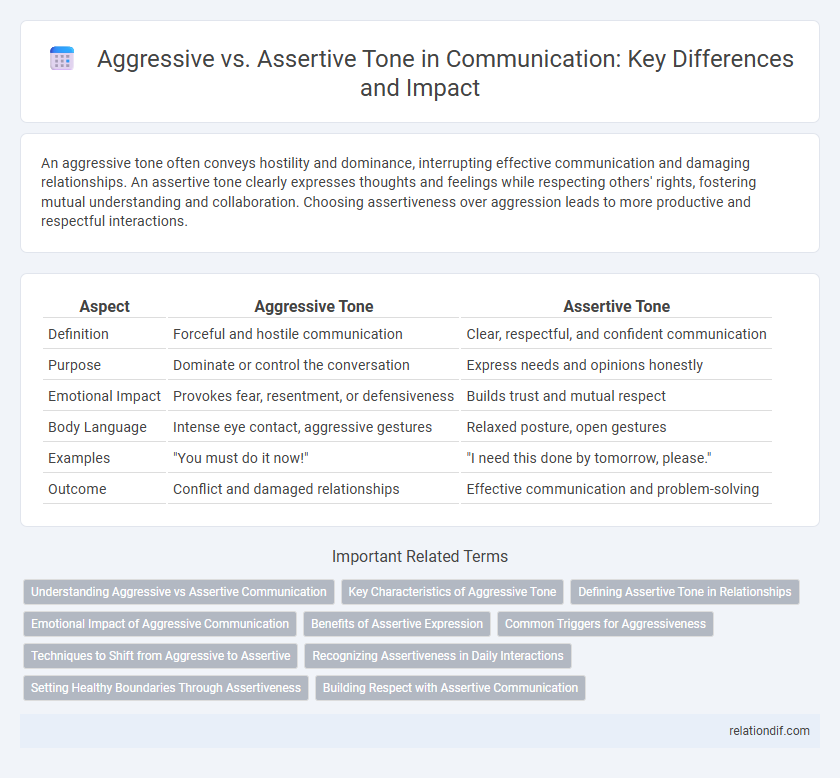An aggressive tone often conveys hostility and dominance, interrupting effective communication and damaging relationships. An assertive tone clearly expresses thoughts and feelings while respecting others' rights, fostering mutual understanding and collaboration. Choosing assertiveness over aggression leads to more productive and respectful interactions.
Table of Comparison
| Aspect | Aggressive Tone | Assertive Tone |
|---|---|---|
| Definition | Forceful and hostile communication | Clear, respectful, and confident communication |
| Purpose | Dominate or control the conversation | Express needs and opinions honestly |
| Emotional Impact | Provokes fear, resentment, or defensiveness | Builds trust and mutual respect |
| Body Language | Intense eye contact, aggressive gestures | Relaxed posture, open gestures |
| Examples | "You must do it now!" | "I need this done by tomorrow, please." |
| Outcome | Conflict and damaged relationships | Effective communication and problem-solving |
Understanding Aggressive vs Assertive Communication
Aggressive communication often involves dominating language, interrupting others, and disregarding their feelings, which can lead to conflict and misunderstandings. Assertive communication, in contrast, respects both the speaker's and listener's rights, employing clear, direct, and respectful language to express needs and boundaries effectively. Mastering assertive communication enhances interpersonal relationships by fostering mutual respect and reducing tension.
Key Characteristics of Aggressive Tone
An aggressive tone in communication is characterized by hostile, dominating language that often disregards others' feelings or perspectives. It involves interrupting, shouting, or using a condescending attitude that can escalate conflicts and damage relationships. This tone prioritizes winning or asserting control rather than fostering understanding or collaboration.
Defining Assertive Tone in Relationships
Assertive tone in relationships involves expressing thoughts and feelings clearly and respectfully while maintaining confidence and openness. It fosters mutual understanding and healthy boundaries by encouraging honest dialogue without hostility or passivity. Using an assertive tone helps resolve conflicts constructively and strengthens emotional connection between partners.
Emotional Impact of Aggressive Communication
Aggressive communication often triggers negative emotional responses such as fear, anger, and resentment, which can damage relationships and undermine trust. In contrast, assertive communication fosters respectful dialogue and emotional clarity, promoting understanding and cooperation. Emotional impact studies reveal that aggressive tones increase stress levels and reduce willingness to engage, while assertive tones encourage positive interactions and conflict resolution.
Benefits of Assertive Expression
Assertive expression fosters clear and respectful communication by enabling individuals to convey their thoughts and needs confidently without offending others. This tone encourages mutual understanding and collaboration, reducing misunderstandings and conflicts in personal and professional interactions. Using assertive communication enhances self-esteem and promotes healthier relationships by balancing honesty with respect.
Common Triggers for Aggressiveness
Common triggers for aggressive tone in communication include perceived threats to self-esteem, frustration from unmet needs, and misunderstandings or misinterpretations. High stress levels and lack of emotional regulation often exacerbate aggressive responses. Recognizing these triggers enables individuals to shift toward an assertive tone, promoting clearer and more respectful interactions.
Techniques to Shift from Aggressive to Assertive
To shift from an aggressive to an assertive tone, focus on using "I" statements to express feelings and needs clearly without blaming others. Maintain calm, steady voice modulation and practice active listening to acknowledge others' perspectives effectively. Implementing empathetic language and setting clear, respectful boundaries fosters constructive dialogue and reduces conflict.
Recognizing Assertiveness in Daily Interactions
Recognizing assertiveness in daily interactions involves identifying clear, respectful communication that expresses thoughts and needs confidently without violating others' rights. Assertive tone communicates confidence through steady eye contact, calm voice, and open body language, distinguishing it from aggressive tone, which is often loud, hostile, and intimidating. Developing awareness of these vocal and nonverbal cues improves interpersonal effectiveness and fosters healthier relationships.
Setting Healthy Boundaries Through Assertiveness
Setting healthy boundaries through assertiveness involves expressing needs and limits clearly and respectfully, fostering mutual understanding without escalating conflict. An assertive tone maintains confidence and calmness, contrasting with an aggressive tone that can provoke defensiveness and damage relationships. Consistent use of assertive communication enhances emotional wellbeing and promotes constructive interactions.
Building Respect with Assertive Communication
Aggressive tone often alienates others by imposing demands and disregarding their feelings, leading to conflict and damaged relationships. Assertive communication, grounded in clear, respectful expression of thoughts and needs, fosters mutual understanding and earns genuine respect. Building respect through assertive communication creates a collaborative environment where open dialogue and trust thrive.
Aggressive tone vs Assertive tone Infographic

 relationdif.com
relationdif.com